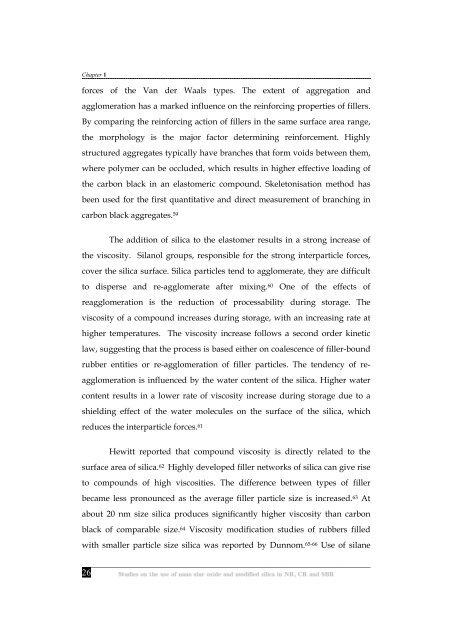Studies on the use of nano zinc oxide and modified silica in NR, CR ...
Studies on the use of nano zinc oxide and modified silica in NR, CR ...
Studies on the use of nano zinc oxide and modified silica in NR, CR ...
Create successful ePaper yourself
Turn your PDF publications into a flip-book with our unique Google optimized e-Paper software.
Chapter 1<br />
forces <strong>of</strong> <strong>the</strong> Van der Waals types. The extent <strong>of</strong> aggregati<strong>on</strong> <strong>and</strong><br />
agglomerati<strong>on</strong> has a marked <strong>in</strong>fluence <strong>on</strong> <strong>the</strong> re<strong>in</strong>forc<strong>in</strong>g properties <strong>of</strong> fillers.<br />
By compar<strong>in</strong>g <strong>the</strong> re<strong>in</strong>forc<strong>in</strong>g acti<strong>on</strong> <strong>of</strong> fillers <strong>in</strong> <strong>the</strong> same surface area range,<br />
<strong>the</strong> morphology is <strong>the</strong> major factor determ<strong>in</strong><strong>in</strong>g re<strong>in</strong>forcement. Highly<br />
structured aggregates typically have branches that form voids between <strong>the</strong>m,<br />
where polymer can be occluded, which results <strong>in</strong> higher effective load<strong>in</strong>g <strong>of</strong><br />
<strong>the</strong> carb<strong>on</strong> black <strong>in</strong> an elastomeric compound. Skelet<strong>on</strong>isati<strong>on</strong> method has<br />
been <strong>use</strong>d for <strong>the</strong> first quantitative <strong>and</strong> direct measurement <strong>of</strong> branch<strong>in</strong>g <strong>in</strong><br />
carb<strong>on</strong> black aggregates. 59<br />
26<br />
The additi<strong>on</strong> <strong>of</strong> <strong>silica</strong> to <strong>the</strong> elastomer results <strong>in</strong> a str<strong>on</strong>g <strong>in</strong>crease <strong>of</strong><br />
<strong>the</strong> viscosity. Silanol groups, resp<strong>on</strong>sible for <strong>the</strong> str<strong>on</strong>g <strong>in</strong>terparticle forces,<br />
cover <strong>the</strong> <strong>silica</strong> surface. Silica particles tend to agglomerate, <strong>the</strong>y are difficult<br />
to disperse <strong>and</strong> re-agglomerate after mix<strong>in</strong>g. 60 One <strong>of</strong> <strong>the</strong> effects <strong>of</strong><br />
reagglomerati<strong>on</strong> is <strong>the</strong> reducti<strong>on</strong> <strong>of</strong> processability dur<strong>in</strong>g storage. The<br />
viscosity <strong>of</strong> a compound <strong>in</strong>creases dur<strong>in</strong>g storage, with an <strong>in</strong>creas<strong>in</strong>g rate at<br />
higher temperatures. The viscosity <strong>in</strong>crease follows a sec<strong>on</strong>d order k<strong>in</strong>etic<br />
law, suggest<strong>in</strong>g that <strong>the</strong> process is based ei<strong>the</strong>r <strong>on</strong> coalescence <strong>of</strong> filler-bound<br />
rubber entities or re-agglomerati<strong>on</strong> <strong>of</strong> filler particles. The tendency <strong>of</strong> re-<br />
agglomerati<strong>on</strong> is <strong>in</strong>fluenced by <strong>the</strong> water c<strong>on</strong>tent <strong>of</strong> <strong>the</strong> <strong>silica</strong>. Higher water<br />
c<strong>on</strong>tent results <strong>in</strong> a lower rate <strong>of</strong> viscosity <strong>in</strong>crease dur<strong>in</strong>g storage due to a<br />
shield<strong>in</strong>g effect <strong>of</strong> <strong>the</strong> water molecules <strong>on</strong> <strong>the</strong> surface <strong>of</strong> <strong>the</strong> <strong>silica</strong>, which<br />
reduces <strong>the</strong> <strong>in</strong>terparticle forces. 61<br />
Hewitt reported that compound viscosity is directly related to <strong>the</strong><br />
surface area <strong>of</strong> <strong>silica</strong>. 62 Highly developed filler networks <strong>of</strong> <strong>silica</strong> can give rise<br />
to compounds <strong>of</strong> high viscosities. The difference between types <strong>of</strong> filler<br />
became less pr<strong>on</strong>ounced as <strong>the</strong> average filler particle size is <strong>in</strong>creased. 63 At<br />
about 20 nm size <strong>silica</strong> produces significantly higher viscosity than carb<strong>on</strong><br />
black <strong>of</strong> comparable size. 64 Viscosity modificati<strong>on</strong> studies <strong>of</strong> rubbers filled<br />
with smaller particle size <strong>silica</strong> was reported by Dunnom. 65-66 Use <strong>of</strong> silane

















